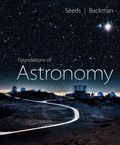
EBK FOUNDATIONS OF ASTRONOMY
14th Edition
ISBN: 8220106820612
Author: Backman
Publisher: YUZU
expand_more
expand_more
format_list_bulleted
Concept explainers
Question
Chapter 1, Problem 8RQ
To determine
The quantity determined by the size of the star.
Expert Solution & Answer
Trending nowThis is a popular solution!

Students have asked these similar questions
Hi! I need help with these calculations for part i and part k for a physics Diffraction Lab. We used a slit width 0.4 mm to measure our pattern.
Examine the data and % error values in Data Table 3 where the angular displacement of the simple pendulum decreased but the mass of the pendulum bob and the length of the pendulum remained constant. Describe whether or not your data shows that the period of the pendulum depends on the angular displacement of the pendulum bob, to within a reasonable percent error.
In addition to the anyalysis of the graph, show mathematically that the slope of that line is 2π/√g . Using the slope of your line calculate the value of g and compare it to 9.8.
Chapter 1 Solutions
EBK FOUNDATIONS OF ASTRONOMY
Ch. 1 - Prob. 1RQCh. 1 - What is the largest dimension of which you have...Ch. 1 - What is the difference between the Solar System,...Ch. 1 - What is the difference between the Moon and a...Ch. 1 - Why do astronomers now label Pluto a dwarf planet?Ch. 1 - Why are light-years more convenient than miles,...Ch. 1 - Why is it difficult to detect planets orbiting...Ch. 1 - Prob. 8RQCh. 1 - What is the difference between the Milky Way and...Ch. 1 - What are the Milky Way Galaxys spiral arms?
Ch. 1 - Prob. 11RQCh. 1 - Where are you in the Universe? If you had to give...Ch. 1 - Prob. 13RQCh. 1 - Prob. 14RQCh. 1 - Prob. 15RQCh. 1 - How do we know? How does the scientific method...Ch. 1 - The equatorial diameter of Earth is 7928 miles. If...Ch. 1 - The equatorial diameter of the Moon is 3476...Ch. 1 - One astronomical unit (AU) is about 1.5 108 km....Ch. 1 - A typical galaxy is shown on the first page of the...Ch. 1 - The time of the Cambrian explosion is listed on...Ch. 1 - Venus orbits 0.72 AU from the Sun. What is that...Ch. 1 - Light from the Sun takes 8 minutes to reach Earth....Ch. 1 - The Sun is almost 400 times farther from Earth...Ch. 1 - If the speed of light is 3.0 105 km/s, how many...Ch. 1 - Prob. 10PCh. 1 - How long does it take light to cross the diameter...Ch. 1 - The nearest galaxy to our home galaxy is about 2.5...Ch. 1 - How many galaxies like our own would it take if...Ch. 1 - Arrange the following in order of increasing size:...Ch. 1 - Prob. 2SOPCh. 1 - The Sun is roughly 100 times the diameter of...Ch. 1 - Prob. 4SOPCh. 1 - Look at the center of Figure 14. Approximately...Ch. 1 - Look at Figure 1-6. How can you tell that Mercury...Ch. 1 - Prob. 3LTLCh. 1 - Look at Figure 1-9. Would you say that the...Ch. 1 - Of the objects listed here, which would be...Ch. 1 - Prob. 6LTL
Knowledge Booster
Learn more about
Need a deep-dive on the concept behind this application? Look no further. Learn more about this topic, physics and related others by exploring similar questions and additional content below.Similar questions
- An object is placed 24.1 cm to the left of a diverging lens (f = -6.51 cm). A concave mirror (f= 14.8 cm) is placed 30.2 cm to the right of the lens to form an image of the first image formed by the lens. Find the final image distance, measured relative to the mirror. (b) Is the final image real or virtual? (c) Is the final image upright or inverted with respect to the original object?arrow_forwardConcept Simulation 26.4 provides the option of exploring the ray diagram that applies to this problem. The distance between an object and its image formed by a diverging lens is 5.90 cm. The focal length of the lens is -2.60 cm. Find (a) the image distance and (b) the object distance.arrow_forwardPls help ASAParrow_forward
arrow_back_ios
SEE MORE QUESTIONS
arrow_forward_ios
Recommended textbooks for you
 Foundations of Astronomy (MindTap Course List)PhysicsISBN:9781337399920Author:Michael A. Seeds, Dana BackmanPublisher:Cengage Learning
Foundations of Astronomy (MindTap Course List)PhysicsISBN:9781337399920Author:Michael A. Seeds, Dana BackmanPublisher:Cengage Learning Stars and Galaxies (MindTap Course List)PhysicsISBN:9781337399944Author:Michael A. SeedsPublisher:Cengage Learning
Stars and Galaxies (MindTap Course List)PhysicsISBN:9781337399944Author:Michael A. SeedsPublisher:Cengage Learning
 AstronomyPhysicsISBN:9781938168284Author:Andrew Fraknoi; David Morrison; Sidney C. WolffPublisher:OpenStax
AstronomyPhysicsISBN:9781938168284Author:Andrew Fraknoi; David Morrison; Sidney C. WolffPublisher:OpenStax An Introduction to Physical SciencePhysicsISBN:9781305079137Author:James Shipman, Jerry D. Wilson, Charles A. Higgins, Omar TorresPublisher:Cengage Learning
An Introduction to Physical SciencePhysicsISBN:9781305079137Author:James Shipman, Jerry D. Wilson, Charles A. Higgins, Omar TorresPublisher:Cengage Learning Stars and GalaxiesPhysicsISBN:9781305120785Author:Michael A. Seeds, Dana BackmanPublisher:Cengage Learning
Stars and GalaxiesPhysicsISBN:9781305120785Author:Michael A. Seeds, Dana BackmanPublisher:Cengage Learning

Foundations of Astronomy (MindTap Course List)
Physics
ISBN:9781337399920
Author:Michael A. Seeds, Dana Backman
Publisher:Cengage Learning

Stars and Galaxies (MindTap Course List)
Physics
ISBN:9781337399944
Author:Michael A. Seeds
Publisher:Cengage Learning


Astronomy
Physics
ISBN:9781938168284
Author:Andrew Fraknoi; David Morrison; Sidney C. Wolff
Publisher:OpenStax

An Introduction to Physical Science
Physics
ISBN:9781305079137
Author:James Shipman, Jerry D. Wilson, Charles A. Higgins, Omar Torres
Publisher:Cengage Learning

Stars and Galaxies
Physics
ISBN:9781305120785
Author:Michael A. Seeds, Dana Backman
Publisher:Cengage Learning